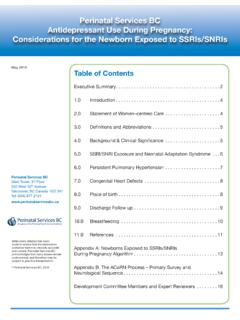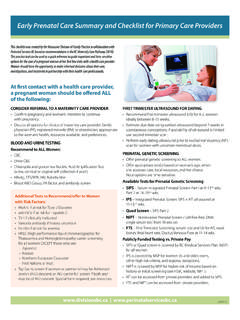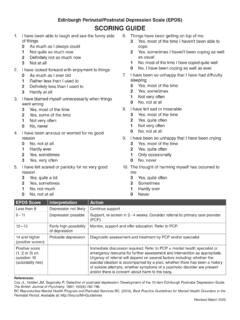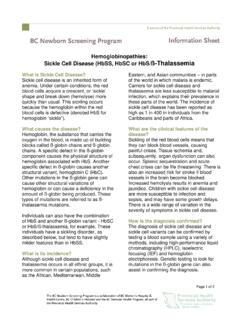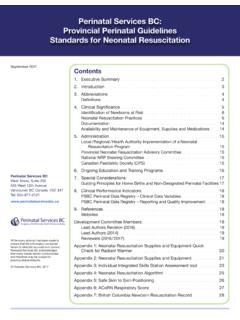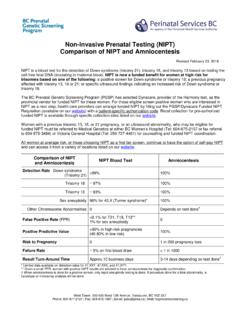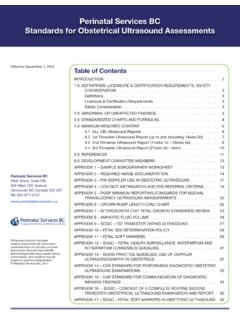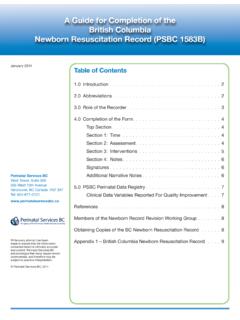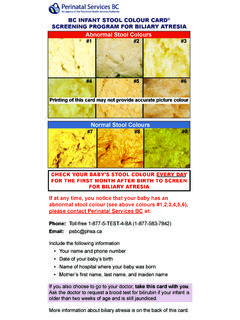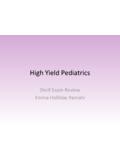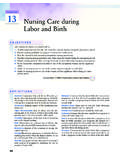Transcription of PSBC Newborn Guideline 13: Newborn Nursing …
1 August 2013(v2 March 2015)While every attempt has been made to ensure that the information contained herein is clinically accurate and current, Perinatal Services BC acknowledges that many issues remain controversial, and therefore may be subject to practice interpretation. Perinatal Services BC, 2013 Perinatal Services BC West Tower, #350 555 West 12th Avenue Vancouver, BC Canada V5Z 3X7 Tel: (604) of ContentsIntroductionAbout the Newborn Nursing care pathway .. 2 Who Updated the Newborn Nursing care pathway .. 2 Statement of Family Centered care .. 2 Referring to a Primary Health care Provider (PHCP) .. 3 Referrals to Other Resources.
2 3 Goals and Needs Health Canada s National guidelines .. 3 Needs World Health Organization (WHO) .. 4 Timeframes .. 4 Newborn Physiological Stability .. 4 Newborn Pain .. 5 Physiological Health Head .. 7 Nares .. 9 Eyes ..10 Ears ..12 Mouth ..14 Chest ..15 Abdomen/Umbilicus ..16 Skeletal/Extremities ..17 Skin ..18 Neuromuscular ..20 Genitalia ..21 Elimination Urine ..22 Stool ..23 Vital signs ..25 Weight ..27 Behavioral ..28 Crying ..30 Infant FeedingBreastfeeding ..32 Breast Milk Substitute Formula Feeding ..36 Health Follow-UpHealth Follow-Up ..38 Immunization and Communicable Diseases ..39 Safety and Injury Prevention.
3 41 Screening/OtherNewborn Blood Spot Screening ..42 Hearing Screening ..43 Biliary Atresia ..43 Glossary of Abbreviations ..44 References & Endnotes ..44 Revision Committee ..47 Perinatal Services BCNewborn Guideline 13 Newborn Nursing care Pathway2 Perinatal Services BCAbout the Newborn Nursing care PathwayThe Newborn Nursing care pathway identifies the needs for care of newborns and is the foundation for the British Columbia Newborn Clinical Path. To ensure all of the assessment criteria are captured, they have been organized into five main sections: Physiological health (organized from head to toe) Behavioural Infant feeding Health follow-up Screening/otherWhile the Newborn assessment criteria are presented as discrete topic entities it is not intended that they be viewed as separate from one another.
4 For example, the Newborn physiological changes affect her/his feeding and behaviour. To assist with this, cross referencing will be used throughout the document (will be seen as Refer ). This will also be evident with the cross referencing to the Postpartum Nursing care pathway as the Newborn and mother are considered to be an inseparable dyad with the care of one influencing the care of the other. An example of this is with breastfeeding as it affects the mother, her Newborn and bonding and attachment. In this document, assessments are entered into specific periods; from immediately after birth to 7 days postpartum and beyond. These are guidelines and are used to ensure that all assessment criteria have been captured.
5 Once the Newborn and her/his mother are in their own surroundings, details of physical assessments will be performed based on the individual Nursing judgment in consultation with the mother. Who Updated the Newborn Nursing care PathwayPerinatal Services BC (formerly BC Perinatal Health Program)1 coordinated the updating of this document. It represents a consensus opinion, based on best evidence, of an interdisciplinary team of health care professionals. The team included nurses form acute care and public health Nursing representing each of the Health Authorities as well as rural and urban practice areas. Clinical consultation was provided by family physicians, obstetricians, pediatricians and other clinical experts as required.
6 Statement of Family Centered care In conjunction with Women Centred care , which places the woman at the center of care , family-centered maternity care , is an attitude/philosophy rather than a policy, and is based on guiding principles2. Key principles have been adapted and are reflected in the Newborn Nursing care pathway . Women and families have diverse birthing experiences (philosophies, knowledge, experience, culture, social, spiritual, family backgrounds and beliefs) thus approaches to care need to be adapted to meet each family s unique needs Relationships between women, their families, and the variety of health care providers are based on mutual respect and trust In order to make knowledgeable and responsible informed decisions in providing Newborn care , women and their families require support and information Parents need to and should be provided with information about Newborn screening/treatments ( prophylaxis, vitamin K and Newborn screening)
7 Including why the treatment is recommended, advantages, side effects and risks if not performed if parents decline screening/treatment, a signed and witnessed informed refusal is required3 The family (Using Women Centred care principles and as defined by the woman) is encouraged to support and participate in all aspects of Newborn care While in hospital (whenever possible), assessments and procedures should be performed in the mother s room (to ensure mother-infant togetherness and to provide anticipatory guidance and information)Introduction3 Newborn Guideline 13: Newborn Nursing care pathway Prior to, during, and following procedures that may cause Newborn discomfort/pain, mothers should be encouraged to comfort their newborns through breastfeeding or skin-to-skin contactReferring to a Primary Health care Provider (PHCP)Prior to referring to a Primary Health care Provider (PHCP) a specific or Newborn global assessment4 (physical and feeding) including history of the pregnancy and labour and birth, will be performed by the nurse.
8 Whenever possible, the woman/her family (supports) are present at the assessment and included in the planning, and implementation of the Newborn s care . In the intervention sections it will be referred to as Nursing to Other ResourcesTo support Nursing practice the following resources are available. Links for many specific resources are included throughout the document. Key resources for parents are: Healthy Families BC Website This website is filled with up-to-date and practical information, useful tools and resources for women, expectant parents, and families with babies and toddlers up to 3 years of age. HealthLink BC HealthLink BC Telephone number accessed by dialing 8-1-1 (Services available health services representatives, nurses pharmacists, dietitians, translation services and hearing impaired services)Goals and Needs - Health Canada s National GuidelinesAs indicated by Health Canada s National Guidelines5 the postpartum period is a significant time for the mother, baby, and family as there are vast maternal and Newborn physiological adjustments and important psychosocial and emotional adaptations for all family members or support people.
9 The following are the goals, fundamental needs, and basic services for postpartum women and their newborns, adapted from Health Canada s National guidelines which are to: Assess the physiological, psychosocial and emotional adaptations of the mother and baby Promote the physical well-being of both mother and baby Promote maternal rest and recovery from the physical demands of pregnancy and the birth experience Support the developing relationship between the baby and his or her mother, and support(s)/family Support the development of infant feeding skills Support the development of parenting skills Encourage support of the mother, baby, and family during the period of adjustment (support may be from other family members, social contacts, and/or the community)
10 Provide education resources and services to the mother and support(s) in aspects relative to personal and baby care Support and strengthen the mother s knowledge, as well as her confidence in herself and in her baby s health and well-being, thus enabling her to fulfill her mothering role within her particular family and cultural beliefs Support the completion of specific prophylactic or screening procedures organized through the different programs of maternal and Newborn care , such as: Vitamin K administration and eye prophylaxis, immunization (Rh, Rubella, Hepatitis B), prevention of Rh isoimmunisation and Newborn screening Assess the safety and security of postpartum women and their newborns (families) ( car seats, safe infant sleeping, potentially violent home situations, substance use)Introduction4 Perinatal Services BC Identify and participate in implementing appropriate interventions for Newborn variances/problems Assist the woman in the prevention of Newborn variances/problemsNeeds World Health Organization (WHO)
